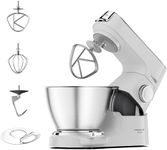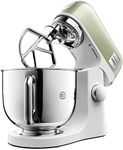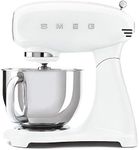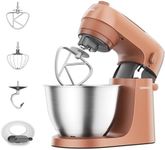Buying Guide for the Best Kitchen Mixers
Choosing the right kitchen mixer can make a big difference in your cooking and baking experience. Whether you're a casual baker or a professional chef, understanding the key specifications of kitchen mixers will help you make an informed decision. Here are some important factors to consider when selecting a kitchen mixer.PowerPower is measured in watts and indicates the strength of the mixer. Higher wattage means the mixer can handle tougher doughs and larger quantities more efficiently. For light tasks like whipping cream or mixing cake batter, a mixer with lower wattage (200-300 watts) is sufficient. For heavier tasks like kneading bread dough, look for mixers with higher wattage (400-800 watts). Consider your typical usage to determine the right power level for you.
CapacityCapacity refers to the size of the mixing bowl and is usually measured in liters or quarts. A larger capacity bowl (5-7 quarts) is ideal for big batches and heavy-duty mixing, while a smaller bowl (3-4 quarts) is suitable for everyday baking and smaller recipes. Think about the quantity of food you usually prepare to choose the right capacity.
Speed SettingsSpeed settings allow you to control the mixer’s speed for different tasks. More speed options provide greater flexibility. Basic mixers may have 3-5 speeds, while more advanced models can have up to 12 speeds. If you need precision for various recipes, opt for a mixer with more speed settings. For general use, fewer speeds may suffice.
AttachmentsAttachments expand the functionality of your mixer. Common attachments include dough hooks, whisks, and paddle beaters. Some mixers also offer additional attachments like pasta makers or meat grinders. Consider what types of recipes you plan to make and choose a mixer with the appropriate attachments. If you enjoy experimenting with different dishes, a mixer with a variety of attachments will be beneficial.
Build QualityBuild quality refers to the materials and construction of the mixer. Mixers made from durable materials like stainless steel or die-cast metal are more robust and long-lasting. Plastic mixers are lighter but may not be as durable. If you plan to use your mixer frequently, investing in a high-quality build will ensure it withstands regular use.
Ease of CleaningEase of cleaning is important for maintaining your mixer. Look for mixers with dishwasher-safe parts and smooth surfaces that are easy to wipe down. Removable attachments and bowls also make cleaning simpler. If you want to minimize cleanup time, choose a mixer designed for easy maintenance.
Size and WeightSize and weight affect the portability and storage of the mixer. Larger, heavier mixers are more stable but can be difficult to move and store. Compact, lightweight mixers are easier to handle but may not be as powerful. Consider your kitchen space and how often you’ll need to move the mixer to find the right balance.














